Abstract
Six isolates of a strain (MRP-MT) of Trichomonas vaginalis obtained from a woman before and after unsuccessful treatment with metronidazole had an appreciably lower susceptibility to metronidazole both in vitro in the aerobic tube assay and in vivo in the mouse assay than did control strains from patients cured with standard doses of the drug. Our results support recent evidence that metronidazole-resistant strains of T vaginalis do cause treatment failure. Resistance of these strains could be detected in vitro under only aerobic but not anaerobic conditions. The prevalence of metronidazole-resistant strains of T vaginalis should be kept under surveillance in order to estimate their clinical importance. The patient harbouring the resistant strain MRP-MT was finally cured with increased doses of ornidazole.
Full text
PDF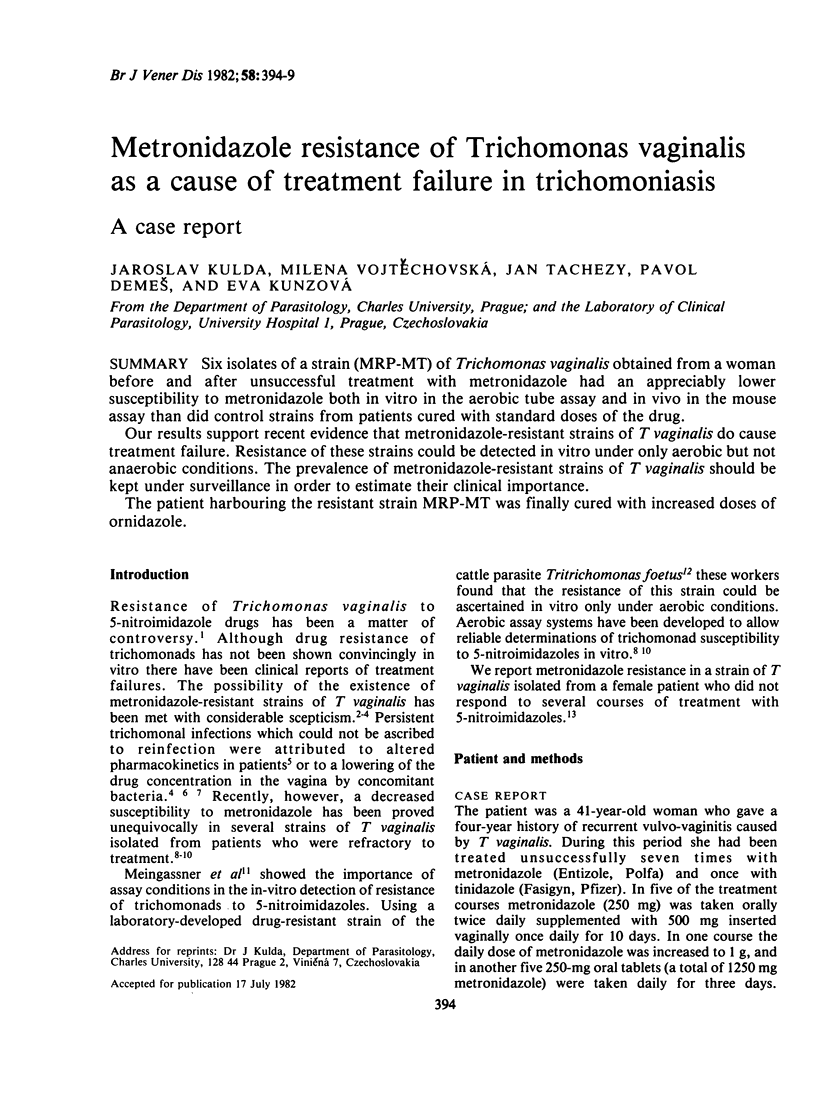
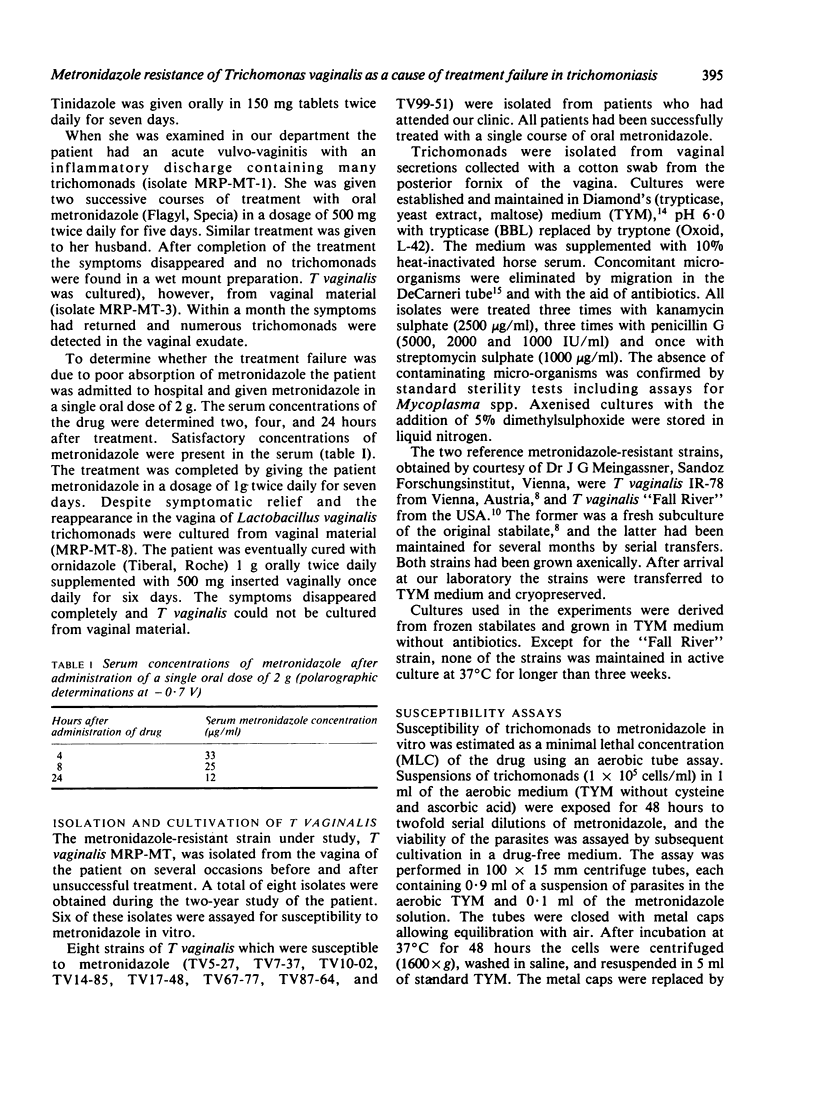
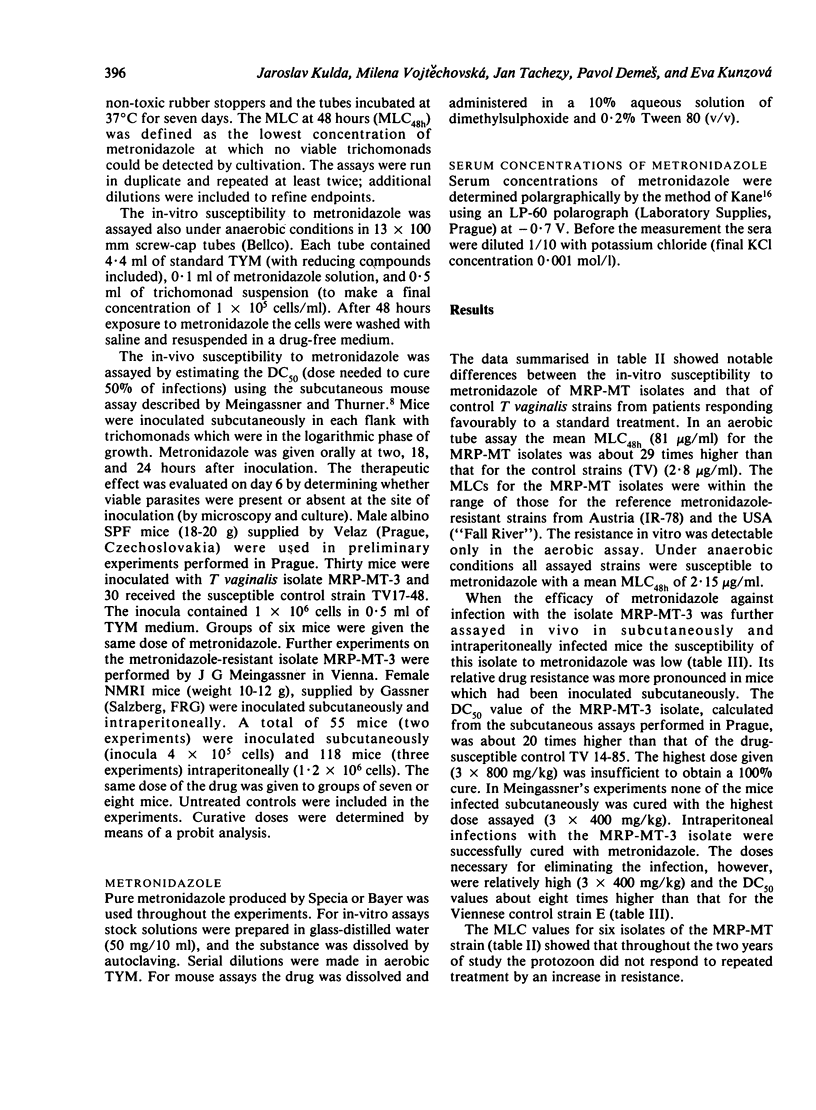
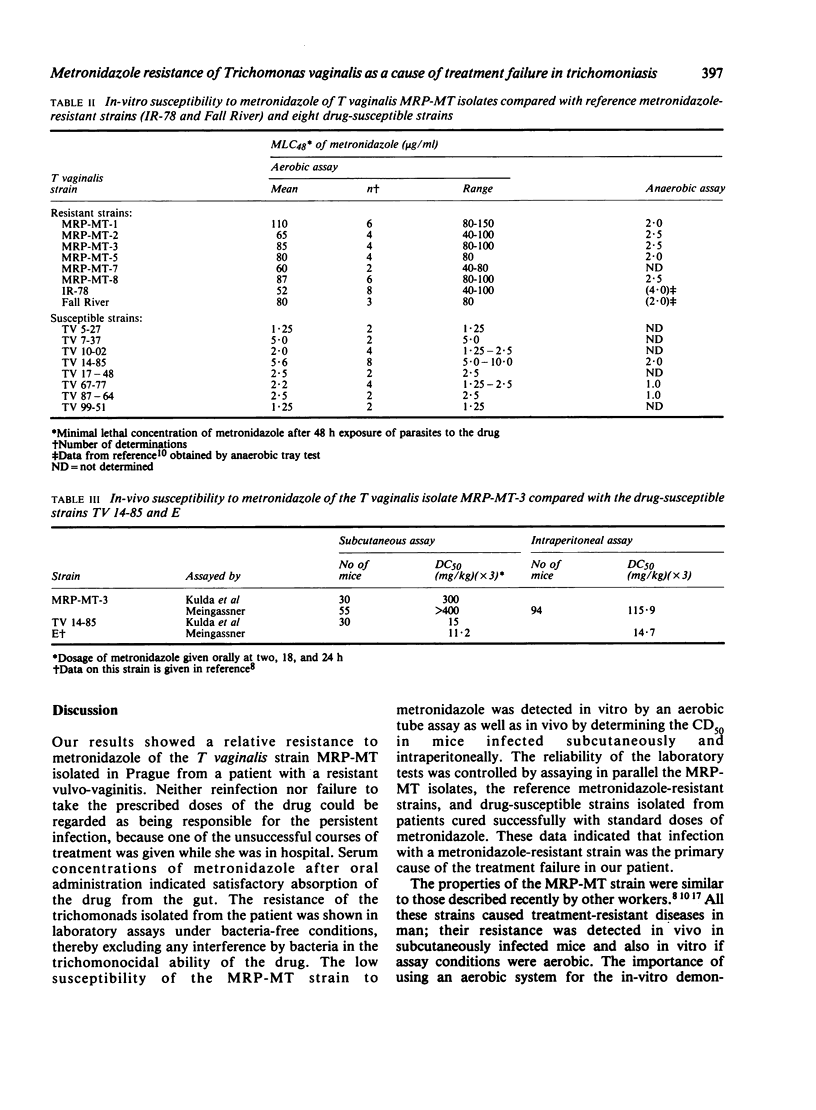
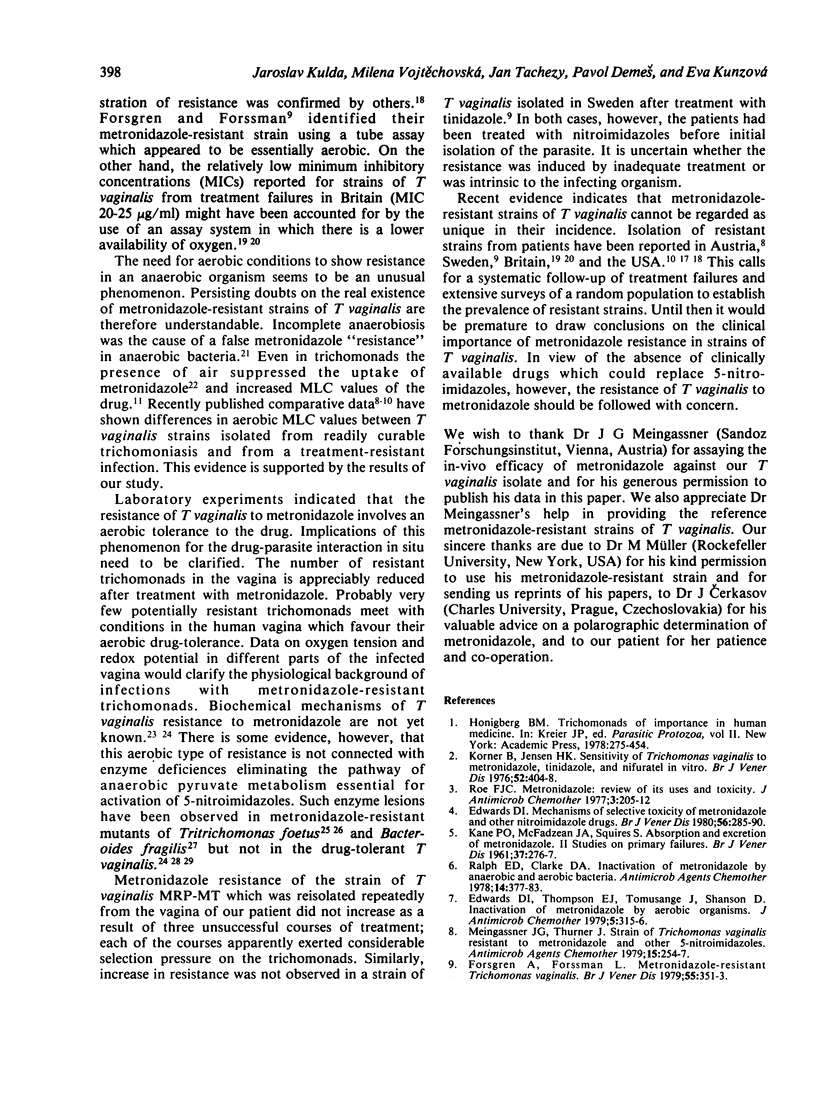

Selected References
These references are in PubMed. This may not be the complete list of references from this article.
- Britz M. L., Wilkinson R. G. Isolation and properties of metronidazole-resistant mutants of Bacteroides fragilis. Antimicrob Agents Chemother. 1979 Jul;16(1):19–27. doi: 10.1128/aac.16.1.19. [DOI] [PMC free article] [PubMed] [Google Scholar]
- DIAMOND L. S. The establishment of various trichomonads of animals and man in axenic cultures. J Parasitol. 1957 Aug;43(4):488–490. [PubMed] [Google Scholar]
- Edwards D. I. Mechanisms of selective toxicity of metronidazole and other nitroimidazole drugs. Br J Vener Dis. 1980 Oct;56(5):285–290. doi: 10.1136/sti.56.5.285. [DOI] [PMC free article] [PubMed] [Google Scholar]
- Edwards D. I., Thompson E. J., Tomusange J., Shanson D. Inactivation of metronidazole by aerobic organisms. J Antimicrob Chemother. 1979 May;5(3):315–316. doi: 10.1093/jac/5.3.315. [DOI] [PubMed] [Google Scholar]
- Forsgren A., Forssman L. Metronidazole-resistant Trichomonas vaginalis. Br J Vener Dis. 1979 Oct;55(5):351–353. doi: 10.1136/sti.55.5.351. [DOI] [PMC free article] [PubMed] [Google Scholar]
- Heyworth R., Simpson D., McNeillage G. J., Robertson D. H., Young H. Isolation of Trichomonas vaginalis resistant to metronidazole. Lancet. 1980 Aug 30;2(8192):476–478. doi: 10.1016/s0140-6736(80)91911-x. [DOI] [PubMed] [Google Scholar]
- KANE P. O., McFADZEAN J. A., SQUIRES S. Absorption and excretion of metronidazole. II. Studies on primary failures. Br J Vener Dis. 1961 Dec;37:276–277. doi: 10.1136/sti.37.4.276. [DOI] [PMC free article] [PubMed] [Google Scholar]
- Korner B., Jensen H. K. Sensitivity of Trichomonas vaginalis to metronidazole, tinidazole, and nifuratel in vitro. Br J Vener Dis. 1976 Dec;52(6):404–408. doi: 10.1136/sti.52.6.404. [DOI] [PMC free article] [PubMed] [Google Scholar]
- Lossick J. G. Metronidazole. N Engl J Med. 1981 Mar 19;304(12):735–735. doi: 10.1056/NEJM198103193041223. [DOI] [PubMed] [Google Scholar]
- Meingassner J. G., Mieth H. Cross-resistance of Trichomonads to 5-nitroimidazole-derivatives. Experientia. 1976 Feb 15;32(2):183–184. doi: 10.1007/BF01937754. [DOI] [PubMed] [Google Scholar]
- Meingassner J. G., Mieth H., Czok R., Lindmark D. G., Müller M. Assay conditions and the demonstration of nitroimidazole resistance in Tritrichomonas foetus. Antimicrob Agents Chemother. 1978 Jan;13(1):1–3. doi: 10.1128/aac.13.1.1. [DOI] [PMC free article] [PubMed] [Google Scholar]
- Meingassner J. G., Thurner J. Strain of Trichomonas vaginalis resistant to metronidazole and other 5-nitroimidazoles. Antimicrob Agents Chemother. 1979 Feb;15(2):254–257. doi: 10.1128/aac.15.2.254. [DOI] [PMC free article] [PubMed] [Google Scholar]
- Milne S. E., Stokes E. J., Waterworth P. M. Incomplete anaerobiosis as a cause of metronidazole 'resistance'. J Clin Pathol. 1978 Oct;31(10):933–935. doi: 10.1136/jcp.31.10.933. [DOI] [PMC free article] [PubMed] [Google Scholar]
- Müller M., Lindmark D. G. Uptake of metronidazole and its effect on viability in trichomonads and Entamoeba invadens under anaerobic and aerobic conditions. Antimicrob Agents Chemother. 1976 Apr;9(4):696–700. doi: 10.1128/aac.9.4.696. [DOI] [PMC free article] [PubMed] [Google Scholar]
- Müller M., Meingassner J. G., Miller W. A., Ledger W. J. Three metronidazole-resistant strains of Trichomonas vaginalis from the United States. Am J Obstet Gynecol. 1980 Dec 1;138(7 Pt 1):808–812. doi: 10.1016/s0002-9378(16)32741-7. [DOI] [PubMed] [Google Scholar]
- Ralph E. D., Clarke D. A. Inactivation of metronidazole by anaerobic and aerobic bacteria. Antimicrob Agents Chemother. 1978 Sep;14(3):377–383. doi: 10.1128/aac.14.3.377. [DOI] [PMC free article] [PubMed] [Google Scholar]
- Roe F. J. Metronidazole: review of uses and toxicity. J Antimicrob Chemother. 1977 May;3(3):205–212. doi: 10.1093/jac/3.3.205. [DOI] [PubMed] [Google Scholar]
- Smith R. F., Di Domenico A. Measuring the in vitro susceptibility of Trichomonas vaginalis to metronidazole: a disk broth method. Sex Transm Dis. 1980 Jul-Sep;7(3):120–124. doi: 10.1097/00007435-198007000-00005. [DOI] [PubMed] [Google Scholar]
- Waitkins S. A., Thomas D. J. Isolation of Trichomonas vaginalis resistant to metronidazole. Lancet. 1981 Sep 12;2(8246):590–590. doi: 10.1016/s0140-6736(81)90984-3. [DOI] [PubMed] [Google Scholar]


